This guide has been updated for 2010! Check it out!
We don’t normally pre-plan our routes in advance so finding a place to set up camp—whether it be just for a night, a few days or several weeks—is something we do on the fly. While many campgrounds take reservations far in advance, we just show up.
Because we’re such a small set up, have solar panels and ample battery capacity—we also don’t often need hook ups. We tend to favor non-commercial campgrounds as we enjoy being off the beaten path, more in nature and spending less.
Whether you plan in advance for your camping or wing it, here are the tools that we use in our search for ideal camp spots. Unfortunately, there does not yet seem to be one unified resource listing all camping opportunities, so we utilize many different resources.
Types of Camping
It’s good to have some familiarity with the types of camping available:
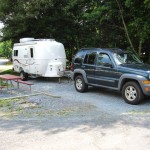 Commercial/Private Campgrounds: Privately owned and operated campgrounds, they can be easy to find. They offer a full range of amenities; from bathhouses, laundry, WiFi, hook-ups, pools, hot tubs, recreation activities, gas/propane, stores and cable TV. These also come at a price, and can be quite crowded leaving little to no room between rigs. There are also membership RV Park clubs that you can join and have access to their park systems.
Commercial/Private Campgrounds: Privately owned and operated campgrounds, they can be easy to find. They offer a full range of amenities; from bathhouses, laundry, WiFi, hook-ups, pools, hot tubs, recreation activities, gas/propane, stores and cable TV. These also come at a price, and can be quite crowded leaving little to no room between rigs. There are also membership RV Park clubs that you can join and have access to their park systems.
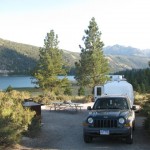 Public Campgrounds: These a government run (city, county, state and national) recreational parks that provide developed camping. The amenities and costs vary widely from just providing a spot to park with a picnic table to full bathhouses and electrical hook-ups, so do your research first if you have requirements. They’re usually a bit off the beaten path in gorgeous non-crowded places and less expensive than commercial campgrounds.
Public Campgrounds: These a government run (city, county, state and national) recreational parks that provide developed camping. The amenities and costs vary widely from just providing a spot to park with a picnic table to full bathhouses and electrical hook-ups, so do your research first if you have requirements. They’re usually a bit off the beaten path in gorgeous non-crowded places and less expensive than commercial campgrounds.
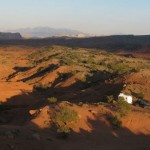 Boondocking/Dispersed Camping: Boondocking refers to camping without provided amenities. Some public lands allow for dispersed camping, which are not developed campsites. The rules vary by agency and location, but generally you just need to find a spot off the road, away from water and leave no trace. Popular boondocking spots have primitive roads or worn trails leading to them. Other boondocking options include staying overnight in Wal*Mart, Flying J, truck stops, rest areas or city roads.
Boondocking/Dispersed Camping: Boondocking refers to camping without provided amenities. Some public lands allow for dispersed camping, which are not developed campsites. The rules vary by agency and location, but generally you just need to find a spot off the road, away from water and leave no trace. Popular boondocking spots have primitive roads or worn trails leading to them. Other boondocking options include staying overnight in Wal*Mart, Flying J, truck stops, rest areas or city roads.
[wp_campaign_1]
Check Maps
We primarily use Google Maps on our iPhones and a Garmin StreetPilot 2720 for our navigating, and will utilize these resources to scope out potential camping locations. Sometimes, just doing a location based search for ‘campground’ or ‘RV Park’ will yield results for us, and then we can further research options from there.
Microsoft Streets and Trips
When we don’t have internet access, we use Microsoft Streets and Trips for offline navigating. Streets and Trips is good about listing commercial and state parks, but can be lacking in campgrounds at national parks, recreation areas, BLM and forests.
After identifying a potential, we check for information about the campground online to get pricing, seasonal openings and reservation requirements. Usually just googling the park name brings up the information we’re seeking, and even sometimes—useful reviews from other campers.
We also take note of any nearby National Recreation Areas, National Forests/Grasslands, lakes and anything that might look like a dam—as these are likely candidates for additional camping resources.
Paper Maps
Yes, even in a digital age – paper maps can be a valuable resource. Some maps are quite good about marking public campgrounds, even if only with a symbol. We carry the Rand McNally Road Atlas 2010,USA/Canada/Mexico with us, as well as a variety of state maps we pick up at welcome centers when we cross into new states.
You’ll still need to research the area to find out the name of the campground. We’ve also found it’s quite often the case that national forests have far more developed campgrounds than maps show, and talking to a ranger is most helpful.
This guide has been updated for 2010! Check it out!
Check for Free/Cheap Campgrounds
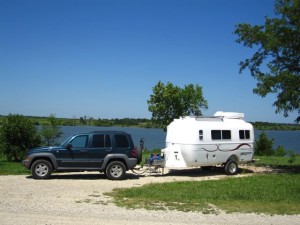
Surprisingly, there are places where you can legally stay for free. These are a mix of boondocking and developed campsites—usually run by small cities (to attract tourists), counties or national services. Some of these have been our most spectacular campsites along our journey.
Some retail locations—where allowed by local ordinances—have also opened their parking lots to overnight stays by RVers, most well known being Wal*Mart, Travel Centers and Casinos. Also, in many states, staying overnight in a rest stop is permissible. Sometimes, you can get away with parking on a public street for a night or two.
Some of our favorite resources for finding free camping:
OvernightRVParking – A wonderful collaborative resource of places for free or cheap overnight parking locations. The cost is $17.95 a year to join (and then you get free extensions when you add information to the database). Our favorite parts about this site are that they show the parking spots on a map (very useful) and provide very detailed information.
FreeCampgrounds.com—a searchable database of free and under $10 camping locations, entered in by other campers. Many listings also have reviews and additional tips on finding the place and confirmations of details. They also keep a database of WalMarts that specifically do not allow overnight parking (usually due to local ordinances.)
FreeCampsites.net – A well designed site with interactive maps cataloging free camping by state run by fellow younger RVers. We love that they utilize maps to find locations. They specialize in scenic public spots, as opposed to retail parking lots for convenient overnight stays.
Boondocking.org—Run by our friend and fellow nomadic-soul, Andrew Koransky, contains a database of coordinates to legal boondocking sites.
These options require some familiarity with the area you’re in or going to, so be sure to know the names of local cities to help in your search.
Check Online Resources
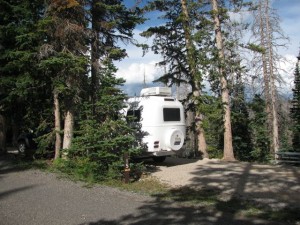
Of course, just searching online via your favorite search engine (Google being ours) yields great results! We find a lot of our great camping by just searching for ‘free campground <city name>’ or ‘free camping’ or other such variations. You’ll find personal blog postings and websites that might mention great places people have found.
The next step we do when researching camping options in an area is to look for resources that might not be a easily findable. We make notes from our map research of other potential camping areas (lakes, National Recreation Areas, National Forests/Grasslands, etc) to help target areas to research. Here are some of the resources that we’ve found to be quite useful:
RV Parking.com— This is a rather new site that we’re quite excited about. It allows users to browse for campgrounds and leave reviews. Unlike other review sites we’ve used, the reviews clearly indicate who left the review and point to their user profile – so you can better find reviewers who enjoy similar camping styles as you do. Our favorite feature is that they also have a free iPhone app to find campgrounds while you’re on the go. The database is still being fleshed out for accuracy – but once it is, we suspect this will be THE place to go to get reliable reviews and information on all sorts of campgrounds. Basically – if we were creating a RV Park guide, this would be how we’d do it. So come join us there, and leave reviews of your own to help contribute to this great project!
State Park Guides—Most states have a central website that lists all their state parks, using Google to find them is generally quite easy. A lot of states have gone to using ReserveAmerica for their online reservations—which is another option for researching. Reserving your site (and paying the ‘convenience fee’) isn’t always necessary unless it’s peak season or a popular spot.
National Park Services— Use this search tool to find information on camping at National Parks (including National.Monuments, National Recreation Areas, etc.)
National Forestry Services—Use this site to look up a forest or grassland for information on both developed and dispersed camping options.
Recreation.gov– The source for reserving government run campsites. It generally only covers the more popular and reserveable campgrounds, so it’s not nearly comprehensive.
Army Corp of Engineers – These are some of the most under promoted campgrounds, and they’re usually quite spectacular —and free to cheap. You’ll have to use their website to track them down, and it’s often times not intuitive to do. Our trick is looking on maps for lakes and dams (where most ACOE campgrounds are), and then searching based on local cities and landmarks.
Bureau of Land Management (BLM) – A government agency managing land in many of the western states of the US. Dispersed camping is generally allowed on BLM land, unless otherwise noted and some even have developed campgrounds.
RV Park Reviews—The long time standard in finding RV Parks and reviews. An older and clunkier user interface than RVParking.com, but a wealth of history of reviews.
Useful Campground Books
We carry a set of campground books in our tow vehicle that give us a quick way to look up relevant information about public camping options we’re considering. Sometimes looking something up online is just more frustrating than it’s worth. The books give us directions, amenities available, descriptions and prices.
The books we carry with us include:
Casino Camping – Guide to RV-Friendly Casinos – 4th Edition
National Park Service Camping Guide, 4th Edition
(Some links above are Amazon.com Affiliate links – if you end up purchasing some of the products we recommend, we’ll get a small cut of the purchase. We only recommend products we actually use ourselves.)
When all else fails: Trust Nomadic Serendipity
 Sometimes, ideal camping spots just manifest themselves when we need them. There have been several times when we’ve found camping spots without looking for them – either by stopping and talking with locals and other travelers, following those handy little campground road signs or not being afraid to peak down a little dirt road into a forest.
Sometimes, ideal camping spots just manifest themselves when we need them. There have been several times when we’ve found camping spots without looking for them – either by stopping and talking with locals and other travelers, following those handy little campground road signs or not being afraid to peak down a little dirt road into a forest.
This guide has been updated for 2010! Check it out!

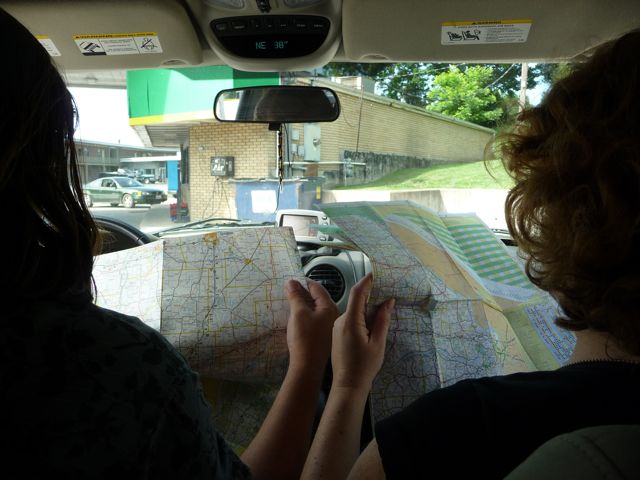

Today was our most lucky day, we meet you guys in Brush, Co. Thanks for the tips. We will try to catch with you again. You are doing great work love State Line. Will be following your travels.
Howdy neighbors!! What awesome serendipity to pull up next to you guys.
Thanks for all the great info….You guys have a very helpful site ,lot’s of great info.My wife and I will be joining you full time on the road in a couple months..Again thanks for your work on this very helpful site …
Thank you for stopping by and reading.. and best wishes with your exodus to the road!
I’m a couple of years away from an RV nomadic lifestyle (I’m in the midst of an airline nomadic lifestyle) but I’m curious. What about cities? Where do you park if you’re in a city for more than a couple of days?
We’re frequently in cities.. and do a combination of street camping, staying with friends and RV Parks. In cities, there are generally multiple RV Park options.. ranging from county and state public options, private campgrounds & resorts and more long term mobile home parks. We’ve done them all 🙂
I am just checking out the Streets and Tips with GPS Locator. Do you think this would be a viable alternative to stand alone GPS satellite navigation devices or is best used as a back up system.
I am using the low tech system of paper maps, which sometimes leaves me or leads me to some interesting locations.
Using Streets & Trips and a GPS unit is a perfectly viable navigation system. We did this for our first year on the road. However, it became a bit cumbersome for us for a couple reasons:
1) We had to run S&T via VMWare, as we’re using MacBookPros.
2) We had to constantly remove/hide the laptop from the tow vehicle when we stopped for walks, rest stops, lunch, etc. As our laptops are our central tech and work machines, we couldn’t risk them getting stolen out of vehicle.
So for us, using our iPhones and a dedicated stand alone GPS device has been working much better for us. If the GPS were to get stolen, it’s not as much of a big deal to us. We’re excited to see what the upcoming iPad might offer as a solution to us.
Just hitting the road and winging it was fun when I was young, but now I like to know where I am going. Back in the day, we did not have the internet like we do now, and that makes planning a trip and finding those secret places much more easy.
You have provided many important resources in this post, thanks!
.-= Bob´s last blog ..Slingshots Throughout History =-.
awesome blog, awesome little casita like trailer!
one of the most valuable camground/boondocking finds was downloading P.O.Is into the GPS
sites like http://www.poifriend.com/
and http://www.poi-factory.com/
have tons of files with great resources like Wyfi hotspots across the country, Eclectic America weird p.o.i, famous death locations, locations of secret waterfalls across the country, boondocking locations, RV safe walmarts…the list goes on and on and they are all free and shared downloads
i have no idea how i traveled before knowing i was passing the Worlds Largest Artichoke, or Black Dahlia crime scene, or the Watts Towers and hey, some of these tourist traps were the absolute BEST place to camp overnite, blending in with all the other tourist.
Thanks for adding my site (freecampsites.net) to your list. I really need to get off my butt and put in some requested features.
.-= Hitekhomeless (jenn)´s last blog ..The timing could be better…. =-.
Informative article, thanks.
When I was van camping through Europe, I’d often find myself looking for a place to camp well after dark without detailed maps or web connections. In those cases I usually looked areas without lights.
Once I’d spotted one of these dark areas, I’d turn off the main road and look for a little dirt road. They always turn up somehow.
Usually, in the morning, I found that I’d parked in some farmer’s field or a forest. Sometimes I’d end up staying a few nights becuase I’d lucked into such a good spot.
We’ve had some wonderful experiences as well just winging it, and some of our best spots have been free boondocking sites we just happened to find. Of course, towing a trailer makes it a bit more difficult if you find yourself down a road that is difficult to get out of 🙂 Thanks for stopping by. – Cherie
I would wholeheartedly agree with you anywhere west of the Appalachian Mountains, but watch out as you go further east. My wife and I just spent a week camping in New Jersey stopping by Delaware Water Gap where RV parking was an after thought and the narrow roads made maneuvering a nightmare. When your travels take you to the east coast call ahead of time to find out about parking for campers and RV’s
Great tips. I usually try to reserve ahead. Recently, We would have missed our chance to go to Myrle beach if I had not reserved a site in advance. Be sure to check you camping checklist before you go. http://www.sightseeingreview.com/campingchecklist.php
Thank you for posting so many helpful links in one place. Excellent reference!